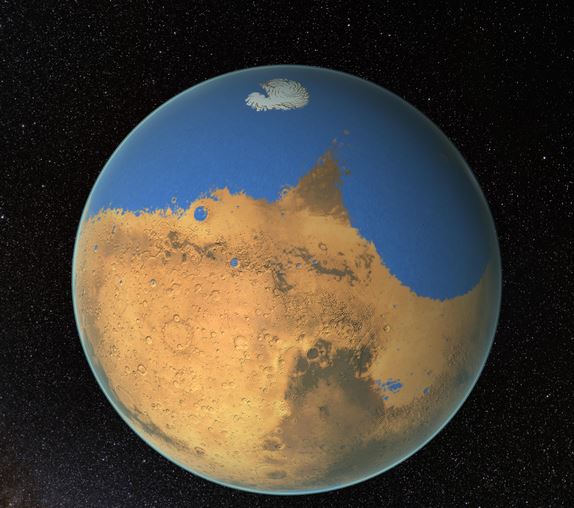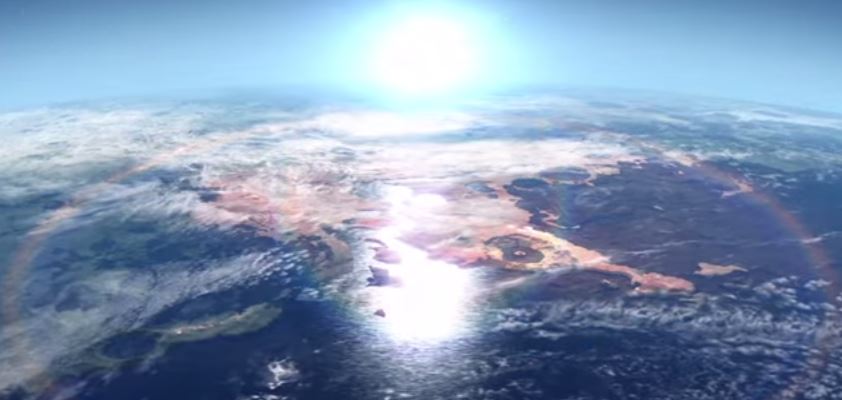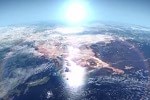Mars used to have a huge ocean, possibly covering half of its northern hemisphere and bigger than the Arctic Ocean, NASA scientists reported this week after measuring water signatures in the atmosphere of the Red Planet.
Researchers and lay people have been wondering for decades whether Mars ever had abundant water, and if so, why it disappeared from the surface.
Details of this latest study have been published in the journal Science (citation below).
Lead author Geronimo Villanueva, who works at NASA’s Goddard Space Flight Center in Greenbelt, Maryland, said:
“Our study provides a solid estimate of how much water Mars once had, by determining how much water was lost to space. With this work, we can better understand the history of water on Mars.”

Mars has lost 87% of its water to space, scientists estimate. It used to have a massive ocean billions of years ago. (Image Credit: NASA/GSFC)
The scientists estimate that maybe about 4.3 billion years ago, Mars had enough water to cover the whole planet with a 450-feet (137-meter) deep liquid layer. They believe it was more likely that nearly half the Red Planet’s northern hemisphere had a vast ocean, with some regions reaching a depth of 1.6 kilometers (1 mile).
Study used three infrared telescopes
The team reached this estimate based on detailed observations made at the NASA Infrared Telescope facility in Hawaii, the European Southern Observatory’s Very Large Telescope in Chile, and the W.M. Keck Observatory in Hawaii.
With data gathered from these powerful instruments, the scientists were able to distinguish the chemical signatures of two marginally different forms of water in the planet’s atmosphere.
One is the familiar water H2O, while the other is HDO (heavy water), a naturally-occurring variation in which one hydrogen is replaced by deuterium (a heavier form).
By comparing Mar’s current HDO to H2O ratio, and comparing it with the ratio in water trapped in a Mars’ 4.5 billion-year-old meteorite, researchers can measure the subsequent atmospheric changes and calculate how much water has escaped into space.
Over a six-year period (three Martian years), the scientific team mapped H2O and HDO levels. The data they gathered produced global snapshots of H2O and HDO, as well as their ratio.
The maps reveal regional variations (micro-climates) and seasonal changes, even though the Red Planet today is essentially a desert.

Early Mars’ surface looked very different when it contained a significant amount of water. (Image: NASA video snapshot)
Villanueva and colleagues were especially interested in the polar regions of Mars, because that is where the planet’s largest known water reservoirs exist. The water stored in the poles is believed to capture the evolution of the Red Planet’s water during the wet Noachian period, which ended approximately 3.7 billion years ago, to the present.
The primitive ocean covered 19% of Mars’ surface
By measuring atmospheric water levels in the near-polar regions, the scientists determined the enrichment, or relative quantities of H2O and HDO in Mar’s permanent ice caps.
The enrichment of the ice caps told the team how much water the planet must have lost – about 6.5 times the volume in its polar caps today. That means that Mar’s primitive ocean must have been at least 5 million cubic miles (20 million cubic kilometers).
As the Northern Plains of Mars consist mostly of low-lying ground, the scientists believe this water was probably located there. A primitive ocean there would have covered nearly one-fifth (19%) of the planet’s surface. On Earth, the Atlantic Ocean occupies 17% of the planet’s surface.
Second author, Michael Mumma, a senior scientist at Goddard, said:
“With Mars losing that much water, the planet was very likely wet for a longer period of time than was previously thought, suggesting it might have been habitable for longer.”
Citation: “Strong water isotopic anomalies in the martian atmosphere: Probing current and ancient reservoirs,” G. L. Villanueva, M. J. Mumma, R. E. Novak, H. U. Käufl, P. Hartogh, T. Encrenaz, A. Tokunaga, A. Khayat, and M. D. Smith. Science aaa3630. Published online 5 March, 2015. [DOI:10.1126/science.aaa3630]
NASA Video – Mars’ ancient ocean
Geronimo Villanueva talks about how much water Mars used to have.

